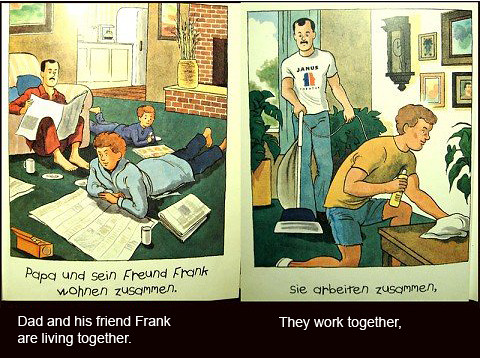Title: Daddy's Roommate
Author and Illustrator: Michael Willhoite
Originally published by Alyson Books in 1991
The main character of this book is a boy whose parents got divorce the previous year. He and his father move in together with the father's roommate; Frank. His father and Frank do everything together. The boy lives both father's and mother's house. At the end, the boy is told that his father and Frank are gay by his mother. He realizes that he is happy with his two "daddies".
This story is definitely about sex orientation and gay acceptance. The author does not mention that the father and Frank are gay until the end. However, we can see that the father and Frank do everything together. I believe that the author wanted to show how gay couple live together or there is no problem to raise a child by two men. I also believe what the author wanted to show mostly is how normal homosexual is. At the time when this book was published in 1991, sex orientation and same-sex marriage were the most controversial issues. According to the video, this book was banned in any parts of this country in 1990s. People took this book away from schools and libraries to keep this book out of children's hands.
This book includes a lot of illustrations and a bit of sentences. This is important for young children to develop their imaginations. However, I feel the illustrations are a little bit of stereotypes. What the father and Frank wear in this book shows typical gays such as shorts and many colored tops. I am not sure that is the trend of clothes at that times. But I feel like the illustration shows typical gay men.
Like I mentioned above, this book describes gay couple's daily life by the perception of the boy. Also, it shows how normal they are like heterosexual couple. We can see the normal life through all pages in this book such as "Dad and his friend Frank are living together. They work together, eat together, sleep together, shave together, and sometimes even fight together" (Willhoite, 1991, p. 3-8).


I choose this book because it relates to my personal life. The knowledge of homosexuals and same-sex marriage have been expanding and accepting in the U.S. The number of states that accept same-sex marriage legally is getting increase. I believe that the number of children who have two daddies or mommies is not zero anymore. However, in the early childhood environment, there are still traditional family style materials such as picture books, songs, finger plays, and toys. I have never seen picture books like this book in preschools. I am sure that there are some parents who do not want their children to look or read this theme books. However, I believe that this is important to show gay acceptance for young children to show two daddies or mommies are normal and nothing different.
The biggest message to children from this book is that "Being gay is just one more kind of love. And love is the best kind of happiness" (Willhoite, 1991, p. 26-27). I totally agree with this; love is love. We should accept that there are many types of family style. This book does not explain gender roles such as men work and women do domestic work for family. This book shows the equality.
At the last, I would recommend this book for children. Some children might feel wondering or weird about this book. This theme to show young children that homosexual is acceptable is not common theme like many books address. I believe that this is disappointing. Preschools or publishers should have more books like this; showing many types of family style. Children mostly get wrong knowledge of homosexuals from their parent's statements or medias. Of course I know that accepting homosexuals relates to beliefs in regions for some people. I understand how difficult to accept it completely. However, from my perception, there is nothing bad about homosexuals or other LGBT people. We cannot change others. Homosexuals is not a choice. Personally, I really really want children to take a look this book and read.
Works Cited
Bliss, Kellie. (2014). Evaluating Children's Literature. Retrieved from https://sierra.instructure.com/courses/245205/assignments/2570955
California Department of Education, Council on Interracial Book for Children. (1998). 10 Quick Ways to Analyze Children's Books For Racism and Sexism. Sacrament, CA; Bill Honig.
Willhoite, Michael. (1991). Daddy's Roommate. New York: Alyson Books.
